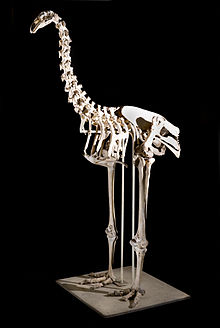
Back Moa meur ar su Breton Dinornis robustus Esperanto Dinornis robustus Spanish غولشترمرغ جزیره جنوبی Persian Moa géant de l'île du Sud French Velika moa Croatian Déli óriásmoa Hungarian Sørøykjempemoa NB Sauth Ailen moa PIH Dinornis robustus Portuguese
| South Island giant moa Temporal range: Late Holocene
| |
|---|---|

| |
| Skeleton, likely of an adult male | |
| Scientific classification | |
| Domain: | Eukaryota |
| Kingdom: | Animalia |
| Phylum: | Chordata |
| Class: | Aves |
| Infraclass: | Palaeognathae |
| Order: | †Dinornithiformes |
| Family: | †Dinornithidae |
| Genus: | †Dinornis |
| Species: | †D. robustus
|
| Binomial name | |
| †Dinornis robustus | |
| Synonyms | |
|
List
| |
The South Island giant moa (Dinornis robustus) is an extinct species of moa in the genus Dinornis, known in Māori by the name moa nunui.[2] It was one of the tallest-known bird species to walk the Earth, exceeded in weight only by the heavier but shorter elephant bird of Madagascar (also extinct).[citation needed]
- ^ Gill, B.J.; Bell, B.D.; Chambers, G.K.; Medway, D.G.; Palma, R.L.; Scofield, R.P.; et al. (2010). Checklist of the Birds of New Zealand, Norfolk and Macquarie Islands, and the Ross Dependency, Antarctica (PDF) (Report) (4th ed.). Ornithological Society of New Zealand / Te Papa Press. Retrieved 30 October 2022 – via nzbirdsonline.org.nz.
- ^ Doyle, Trent (15 November 2023). "Scientists reveal fossilised moa footprints in Otago are at least 3.6 million years old". Newshub. Retrieved 23 February 2024.